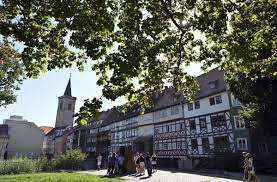
A U.N. committee on Sunday named a group of medieval Jewish sites in the eastern German city of Erfurt as a World Heritage Site, the second time Jewish heritage in Germany has been added to the list in recent years.
Among the buildings included in the new designation are Erfurt’s Old Synagogue, a 13th-century stone building that illustrates Jewish family life in the medieval era, and a traditional ritual bath, or mikveh.
The decision was made at a meeting of the U.N. World Heritage Committee in Riyadh, Saudi Arabia, under the auspices of the U.N. Educational, Scientific and Cultural Organization, UNESCO.
The ritual bath was filled in and used as a cellar for centuries and was only recognized for its historical and cultural background in 2007.
Paris-based UNESCO began the World Heritage List in 1978. It includes a broad array of over 1,000 sites — from the Acropolis in Athens to the Great Wall of China — nominated by their respective nations.
Sunday’s news comes two years after UNESCO first recognized Jewish cultural heritage sites in Germany. That year, it added the so-called ShUM Jewish sites in the Rhine river cities of Mainz, Worms and Speyer to its list of World Heritage Sites.
UNESCO’s choice to also add Erfurt “makes a further important contribution to making the common roots of Jews and Christians in Germany and Europe visible and preserving them for the future,” Kerstin Puerschel, Germany’s ambassador to UNESCO, said in a statement.
The inclusion of Erfurt brings the total number of World Heritage Sites in Germany to 52.





